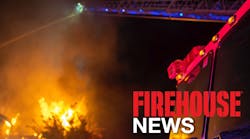This is just one scenario. There are any number of situations that can lead to a firefighter MAYDAY. Consider the above scenario or think about a situation in your community that could produce a similar result. What have you, and your department, done to manage your own personal MAYDAY?
Temporary confusion is not an emergency but it can lead to one. In the event that you're able to quickly solve the problem the following considerations may not come into play. Don't jump the gun but don't allow tunnel-vision during a true emergency be the cause of tragedy. Consider the following actions as some of the problem-solving steps to use during your MAYDAY:
Orient Yourself
While this may be a difficult thing to do - take a few seconds to calm down and get your bearings. What's the status of your air supply? What were you doing? Were you near a wall? Advancing or following a hose line? Were you on the first floor, second floor, in the basement? Who was with you and where are they now? By performing a quick assessment of the situation you may be able to quickly solve it. Don't panic and begin moving aimlessly throughout the structure - your entry should have been systematic and your actions during this problem solving should be the same.
Communicate with Your Crew
There should be at least one other firefighter with you! Are you separated? Can you communicate? Constant communication during fireground operations is essential, especially among individual crews. If for some reason you are unable to contact your crew then it's likely they don't know your situation.
Fireground noise makes it difficult to hear, period! Radio technology doesn't help the situation. Does every member on the fireground carry a portable radio? If not, is there at least one radio per inside crew? Where do you carry your radio? In your chest pocket? Pants pocket? Do you use a lapel microphone? Can you hear everything that is being relayed over the radio? (Probably not!) Consider these things when trying to contact your crew inside a structure.
Consider the normal course of action in notifying your crew. The first thing that's usually done is simply calling out to the other crew members - through an SCBA. If the crew isn't real close then they probably can't hear you. A radio transmission may come next - if everyone carries a radio. What happens next if those attempts fail? One other option is sounding a tool. Make as much noise as possible with the tool and/or activate your PASS device (see below). Don't give up in trying to communicate inside the structure but don't let tunnel-vision prevent you from dealing with the real problem!
Alert Command
This is the time that the radio you've always carried pays for itself - if you use it! All too often a firefighter in trouble waits until late in the stages of the situation before calling for help - Why? The easiest thing to do - if the problem is overcome - is to make another radio transmission declaring the problem solved. Whether you're injured and can't move or simply disoriented and beginning to troubleshoot the problem, notifying Command is an early step in the process. In the event that you're unable to solve the problem help is already on the way.
Some of the more important things to relay to Command are: your unit number, the problem, your location (or last known location), what assignment you were performing and the status of your crew. It may be that your crew is unaware of the problem or they may be actively working to correct it - in any case it is important for accountability reasons.
Solve the Problem
The above actions during your MAYDAY should take only a few seconds. Dealing with the problem should be your highest priority - and the above actions are part of dealing with it. Over the past few years there has been a tremendous amount of emphasis placed on Get Out Alive, Firefighter Survival, and Rapid Intervention training. During your MAYDAY, we can only hope that you've been paying attention and been involved in this type of training. There are a number of skills that can be attempted to solve your MAYDAY and it's time to put them to the test. Use what you've learned - improvise if you have to - to find a way to solve your problem and get out. Help should already be on the way. Don't omit the next step if your initial attempts to solve the problem don't succeed!
Activate Your PASS
This means manual alarm mode - it should already be turned on! One of the first things that all firefighters need to focus on is the sound of an activated PASS device during fireground operations. The first thing that should be done when you hear a PASS device going off is to check and make sure it isn't your own. If it is then reset it! How many times have you ignored a nearby PASS device? How often was it yours? How many times have you let an activated PASS device move right by you?
During your personal MAYDAY, activate your PASS device to alert others that you need help. If the members of your department are trained and conditioned to proactively react to an activated PASS device then they'll know somebody is in trouble. You may only be a few feet from other firefighters but they won't know unless they hear you. Don't focus solely on solving the problem and become so exhausted or overcome that your PASS device must remain motionless for 25 to 30 seconds before it activates. That 30 seconds may allow the RIT to pass right by - they should be moving at a pretty fast clip because they're searching for a firefighter in trouble. Why take a chance!
Solve the Problem
This was discussed just before Activating Your PASS but is repeated here because it is critical to continue trying to solve the problem. Seconds count! Remain calm, orient yourself, know that help is on the way (you've broadcast a MAYDAY and activated your PASS), and systematically attempt to solve your problem.
If You Can't Solve The Problem
If you're unable to solve the problem then do everything you can to make sure the RIT can locate you. Communicate with Command again. Communicate with the RIT if possible. Make sure your PASS is activated. Sound with a tool. At this point the success of the operation hinges on the RIT's ability to find you. Make sure you and your department are prepared in the unlikely event that you find yourselves in this situation!
MAYDAY Training Sessions
There are a number of Get Out Alive, and Rapid Intervention skills that can be done during company training sessions. The following training sessions should focus on the above steps for solving your MAYDAY. All of these drills should be done using SCBA in no visibility conditions.
Find a Hose line and Follow to Safety
This session involves orienting yourself inside the structure, finding a hose line, determining the direction to safety and following the line out. Use a vacant structure, training facility or the apparatus floor and lay out a charged attack line. Incorporate loops in the line and place obstacles to be encountered (furniture, etc.). In no visibility conditions place a firefighter away from the attack line and have them find their way out. Add a few smoke detectors for sound and distraction. Make sure the loops and obstacles provide the firefighter with a challenge. Do your firefighters know how to follow the couplings out of a building?
Alert Command & PASS Device
Using the same scenario as above, have the firefighter locate the line and move to safety. At a point in the line provide an obstacle (a closed apparatus door works well) that can't be overcome. At this point the firefighter should alert command of the problem and provide information that will assist in locating and removing him. The information should include the line and the obstruction. After the transmission the firefighter should activate his PASS device. Depending on the size of the structure there may be an exit or exterior wall nearby. Try anything to get out but don't get too far away from the location the RIT is coming to.
Additional Training...
Every firefighter, and department, should participate in Get Out Alive and Rapid Intervention Team training. Sending firefighters into structures without providing them training to respond to their own emergencies should not be allowed. Sending, or assigning, rapid intervention teams that have not trained to perform rapid intervention skills is like not having a rapid intervention team at all.
How have you prepared to handle your own MAYDAY? Send in any tips or techniques you have come up with so that they can be shared with others.
Jim McCormack has been a firefighter for 15 years and is currently with the Indianapolis Fire Department. Jim is also the founder and president of the Fire Department Training Network, a membership network dedicated to firefighter training.




